![]()
![]()
![]()
![]()
![]()
![]()
![]()
![]()
![]()
![]()
![]()
![]()
![]()
![]()
![]()
![]()
|
|
|
|
|
|
|
|
|
|
|
|
|
|||||||
|
|||||||||
|
|
|
|||||||
January 2000 Film Music CD Reviews |
Film Music Editor: Ian Lace |
|
Return to the January Index with thumbnails Part 2
************************************************************** EDITOR’S CHOICE OF THE MONTH
**************************************************************
Conducted by Allan Wilson
HOLLYWOOD HR-62262 [68:02]
Save around 22% with
Amazon US
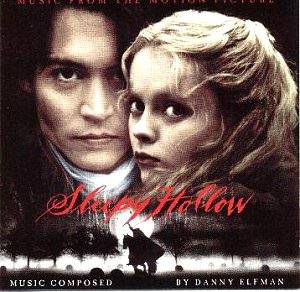
I leaned over to my companion as we left the theater after seeing Tim Burton's fanciful showpiece about a preternatural horseman (who happens to be quite cunning for a guy with nothing up top). "'Who did the score?' is a bit of a no-brainer," I told her, grinning.
"Danny Elfman sure used his head..." she replied.
The score for "Sleepy Hollow" is massive. There are very few breaks in the musical narrative, the orchestrations are possibly the most complicated to appear on an Elfman soundtrack, and the thematic material, though phenomenal, is repetitive, yet is so widely arranged to cover emotions as disparate as horror to mystery to elegance to romance that it never grows tiresome. The percussive & bold low brass and strings are wonderful effects, and the choral lines (performed by the Metro Voices and the London Oratory School boys choir) are atmospheric, but not in the hokey manner indicative of the horror genre's lower-rate productions.
There is also structure to the growling brass and quivering strings. The music builds slowly over the course of the film rather than building, pulling back, and building again. (The closest Elfman comes to this is the track 'The Story...' which is basically a miniature score unto itself, telling a crucial, but seemingly separate, tale. This track, the main title overture, and the rantipole 'The Chase' are direct, accessible examples of the film scoring craft at its best.)
Danny Elfman freely admits to cadging musical textures from his heroes. However, he presents one of his most original creations here. There are bits of his primary inspirations, the music of Bernard Herrmann and Igor Stravinsky, as well as past Elfman scores (and their nods), but these are not distracting and fit together seamlessly in surprisingly novel ways. It is a quodlibet aimed at generating supernatural moods, whilst unmistakably an Elfman soundtrack above all.
Soundtracks that one cannot 'get into' initially, yet reveal exciting secrets upon repeat listening, are horribly underrated -- dismissed too easily by listeners intent on quick fixes and condensed albums. They are like the proverbial ugly duckling turning into a graceful swan. The methodical nature of the "Sleepy Hollow" underscore and the hour+ length of the disc may force the work into this category by some, but are blessings in disguise. Focusing on the music's flow, it becomes radically listenable. The joy and drama driven forward by the intent are perfectly illustrated by the execution. "Sleepy Hollow" is well accomplished.
Reviewer
Jeffrey Wheeler

Ian Lace agrees:-
Danny Elfman has reached deep into his magic bag of grotesqueries and pulled out truly impressive Gothic writhings for this score that threatens to out-Berlioz, Berlioz in his Witch's Sabbath mode; and grisly enough to make Mussorgsky green with envy. This huge dark score spins the traditional horror/ghost genre score out to, what one must imagine is its absolute limit.Elfman's Sleepy Hollow is tremendously complex and richly textured with impressive use made of the voices and a lone soprano in the extremis of a lost soul. I will not cover Jeffrey's ground again save to add a note about just three of the tracks. 'Into the Woods/ The Witch', 'The Tree of Death (9½ minutes duration), and 'The Windmill' are all highly evocative with Elfman delivering mind-boggling effects. The few serene moments are equally convincing with a nicely understated 'doomed' romantic theme.
Prepare to be scared, really scare for this is truly the stuff that nightmares are made of.
Ian Lace

************************************************************** EDITOR’S CHOICE OF THE YEAR 1999
**************************************************************
OST Gilda Buttà (piano); Amedeo Tommasi (piano); Gianni Oddi (soprano saxophone); Academia Musicale Italiana conducted by the composer.
SONY SK66767 [51:41]

What a pleasure this album is. This is a good old-fashioned score, reminiscent of Steiner and Korngold, with a gorgeous, heart-warming main theme -- a broad-spanned, memorable melody, the sort that is cherished by all incurable romantics. Furthermore, all 21 tracks on this CD are interesting. One gets to, say track 14 - a meltingly beautiful Debussy-like piano solo ‘Nocturne with moon’, and one thinks, surely there can’t be anything more as good as this, and all the music that has gone before, but the album continues to enchant. Of how many film music CDs, can one honestly make such a commendation?
I have not seen the film but the blurb from Sony’s publicity department, suggests that it is "a film about music, and an extraordinary tale of a virtuoso musician born at sea." Taking into account the cover artwork showing a liner at sea, and the song, ‘Lost Boys Calling’ which is the final track, one might assume some sort of nautical tragedy à la Titanic happens at some point in the story. I must say, though, that the song, when it comes, delivered by Pink Floyd’s Roger Waters with guitar solos by Eddie Van Halen is, to my mind, more appealing than Ms Dion’s ‘My Heart Will Go On.’
The score opens with a statement of the ‘1900’s Theme’ which is soon interlaced with some Gershwin-style jazz to, presumably, connect the Old World with The New’? This lasts just 1½ minutes but it is followed by an 8-minute cue, featuring Fausto Anzelmo (viola) and Gianni Oddi (soprano saxophone), ‘The Legend of the Pianist’, in which this main theme is declared in full sweeping, passionate mode. The cue also contains seascape music that would not have shamed Debussy or Atterberg, together with more jazz material.
Jazz is an important element in this score. There are source music cues like Scott Joplin’s ‘Peacherine Rag’ and Jelly Roll Morton’s ‘The Crave’. But there are also many more original jazz cues written by Morricone and Amedeo Tommasi whose breath-takingly nimble fingers impress in renderings of them all. Another pianist, Gilda Buttà is used for the more classical tracks. She makes her first appearance on ‘The Crisis’ which must be a crisis of confidence for the student virtuoso pianist because he keeps hitting a wrong note that persists through this cue – and throughout ‘Child’ an engaging little piece with flute solo and orchestra. But it is in her beguiling and poignant solo, ‘Playing Love’ that she really impresses. ‘Playing Love’ is also an earlier highlight of the album this time given, in effulgent splendour, to the orchestra.
I cannot praise this album too highly. It is my film music CD of 1999.
Reviewer
Ian Lace

************************************************************** EDITOR’S RECOMMENDATION January 2000
**************************************************************
OST featuring Terence Blanchard (trumpet); John Patitucci (bass); Harvey Mason (drums) and Dave Grusin (piano).
SONY SK51336 [50:27]
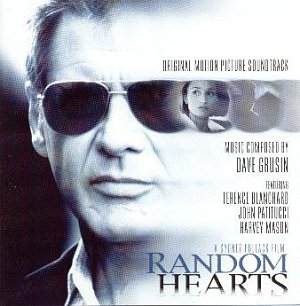
Random Hearts tells the story of two people: tough-minded (of course) internal affairs cop, Dutch Van Den Broek (Harrison Ford), and Kay Chandler, a high profile Congresswoman (the delectable Kristin Scott Thomas) who never would have met in a perfect world (so says the publicity blurb). Dutch is involved in a high-stakes corruption case and Kay is embroiled in a bitter re-election campaign. Quoting the blurb again, "they develop an extraordinary relationship that forces them to confront the truth that threatens to destroy them and discover the strength to triumph over the deception that surrounds them."
Director Sidney Pollack, wanted a rather different score for this unusual love story and went back to Dave Grusin for the answer. [Random Hearts marks their ninth collaboration.] Grusin has more than 40 film scores and TV themes to his credit. He won an Oscar for Robert Redford’s The Milago Beanfield War (1989) and Academy Award nominations for his work on: On Golden Pond, Tootsie, Heaven Can Wait; The Graduate; The Fabulous Baker Boys; St Elsewhere and Baretta. Amongst his other film scores I particularly enjoyed his music for Falling in Love (a much under-rated film, I have always felt).
Not surprisingly, Grusin’s score for Random Hearts is very much jazz-based with a quartet made up of the personnel named in the header to this review stiffened with strings and other instrumentalists as each track requires. There are two source songs: Diana Krall sings Jerome Kern’s evergreen ‘The Folks Who Live on the Hill’, endearingly supported, quietly and sympathetically by the quartet; and Patty Larkin gives an equally appealing rendition of her own song, ‘Good Thing.’
The material of the other tracks is nicely varied adding up to a very satisfying programme, ideal as background for dinner, dancing or late night listening. A mood of uneasy and diffident romance is set with the opening slow moving ‘Looking for Peyton’ cue played by the quartet. Then in the following ‘Dutch’, a flurry of altogether darker more disturbing strings material floats across the basic jazz-rhythm ostinato figures with slight volumes of growling synth. The tense, dissonant and cold thriller-style material is heard again in the opening minute or so of ‘Keys,’ and in ‘Closing In.’
It is, however, the more romantic material that predominates in this score most notably in the bitter-sweet ‘Random Hearts (Love Theme)’, the extra colour, drama and poignancy of ‘Intimate Distance’ and in the lovely quiet introspective melody for strings, piano and harp strings that is ‘Passengers.’ ‘Seasonal changes’ from the quartet (joined by the strings) is a haunting little vignette. As if all this was not enough we are treated to two exotic and colourful, infectious Latin numbers: ‘Playa Del Sul’ and ‘Aquí en Miami’ for which suitable instrumentation is imported to create the requisite vibrant atmosphere.
Unhesitatingly recommended and for me this is one of the few memorable new scores of 1999.
Reviewer
Ian Lace

Score composed and produced by Mark Isham, conducted and orchestrated by Ken Kugler ; album also includes seven 'rock and roll' songs from the 1950's
SONY SK 61696 [Total time 52:42 -- Score: 35:42 / Songs: 17:00]
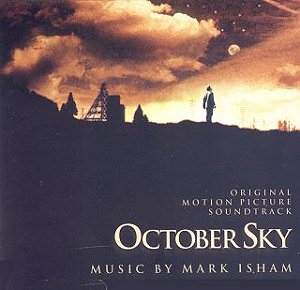
October Sky is director Joe Johnson's first feature since 1995's Jumanji, and a distinct change of pace. After that special effects dominated blockbuster, comes a low-key, sensitive study of youthful dreams. Based on a true story, adapted from the book "Rocket Boys" by Homer H. Hickam Jr., the film is set at the dawn of the Space Race, in small-town West Virginia in the Autumn of 1957. Sputnik is in orbit, and four teenage boys long for the stars and experiment with building their own rockets. Here, following a decade of directing escapist fantasy - The Rocketeer, Honey, I Shrunk the Kids, The Pagemaster, The Young Indiana Jones Chronicles - Johnson offers a more mature examination of the urge to escape itself, resulting in a film which has garnered by far the finest reviews of his career. Unfortunately the film did only moderate business in the States, and despite being scheduled for a December 10 release in the UK, has yet to reach our screens.
There is another way in which October Sky marks a change for Joe Johnson: it is his first feature not to be scored by regular collaborator James Horner. Perhaps Horner is now too expensive for such a comparatively small scale project, but Mark Isham, for whom this is just one of at least nine scores this year, makes a fine replacement. This is a score characterised by wistful nostalgia, yet of a kind devoid of sentiment, built upon folk-like, hymnal elements and a simply gorgeous central melody. There are 17 score selections, totalling 35 minutes, yet this music is very much of a piece, the complete score being far greater than its individually lovely parts. Or at least it is if you take the trouble to programme your CD deck before pressing play, for this is one of the most thoughtlessly sequenced CDs I have recently encountered.
Besides the score, the album contains seven 1950's popular tunes used as source music in the film. There is nothing wrong with this, and I have no problem with the songs. However, given that the valedictory, orchestral sound of the score is so at odds with the 'rock and roll', it seems ridiculous to shatter the mood every few minutes by interspersing one or two of these tunes. Presumably the music has been sequenced here in the order it appears on screen, but a CD is not a film and far more sensible would have been to place the 17 minutes of 'rock and roll' together either at the beginning or end of the disc. Few film music aficionados are going to be interested in these tunes, or if they are, they will probably already have them elsewhere on various pop releases, while 'rock and roll' fans aren't going to be buying the soundtrack of October Sky to get these numbers.
The opening 'Coalwood' introduces the main theme on solo violin, and the first thing that may spring to mind is the opening of James Horner's Legends of the Fall. While a Horner influence is detectable in various places in the score - notably beginning 54 seconds into 'The Search for Auk 13', which just might be a deliberate in-joke reference to Titanic - Isham brings his own elegant style to the score. There is an overwhelming mood of dignified melancholy to this music, an American sound that will appeal to those who appreciate the more sombre romanticism both of Samuel Barber and John Williams. While there is a pleasingly light-hearted feel to certain sequences, by the time the title track gets under way, and if Joe Johnson has done his job properly, there won't be a dry eye in the cinema. 'October Sky' ends the score with a statement of the main theme which is at once noble, reflective, nostalgic, and aching with resignation. For this tale of coming of age in the space age, Mark Isham has employed all his innate taste as a jazz man and all-round musician, and has crafted a spare and finally honed work which has all the hallmarks of a classic Americana score. It is, quite simply, one of the year's best, and should not be missed.
Reviewer
Gary S. Dalkin

Original Television Score
VARÈSE SARABANDE VSD-6071 [44:16]
Save around 22% with
Crotchet
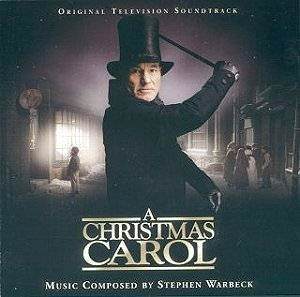
Following Merlin, Journey to the Center of the Earth and Animal Farm, here is yet another lavish Hallmark TV movie. This time Charles Dicken's much filmed family favourite returns with Patrick Stewart's Scrooge boldly going where so many fine actors have gone before. Accompanying him in the highly acclaimed film are Richard E. Grant, Saskia Reeves and Celia Imrie, Dominic West and Joel Grey.
If the cover art and stills of the soundtrack CD are any indication, this is an appropriately dark and gothic treatment of the classic. Surrounded by darkness, a black-clad Patrick Stewart looks thoroughly menacing and certainly in need of redemption.
There are many soundtrack albums that can be enjoyed purely as a musical entity, quite disconnected from the subject of the film the music was written to accompany. Others are, for various reasons, necessarily intimately entwined with the subject of the movie. Here is one such score, and an excellent one it is too. Over 29 often very short tracks Stephen Warbeck builds a musical tapestry which balances his own new themes with instantly recognisable music of the Christmas season.
The opening 'Funeral' is filled with serene foreboding, leading to an elegant and very English main theme first stated in 'Walking Home'. A warm brass arrangement of 'O Little Town of Bethlehem' is contrasted with the chill strings which herald the appearance of 'Marley's Ghost', while 'The Torture of Remorse' is glacial in its emotional bleakness. A sombre treatment of the main theme is given in 'Wandering Ghosts', an echo of the darkest moments of the composer's Oscar-winning Shakespeare in Love. 'The Ghost of Christmas Past' has an utterly lovely sense of pastoral melancholy, the brief 'Fran's Tune', is a lyrical pipe lament.
'Fezziwig's Party', a longer track divided into four sections, is a very different affair, offering a lively jig and a jolly song, a polka and a waltz, all linked with cheery sounds of celebration. 'Scrooge Alone' provides another beguiling melancholy melody, with now a greater human warmth being expressed by a solo violin. More atmospherics lead to a setting of 'Silent Night', the deliberately unpolished voices evoking the genuine sound of carol singers, rather than the beauty of a choral treatment. Several other Christmas melodies appear in various guises, 'The First Noel' and 'God Rest You Merry Gentlemen', between them lie passages of breathless spectral beauty, delicate orchestration shimmering like cold fire balanced between the light and the dark. A questing urgency appears in the relentless strings of 'Ignorance and Want', before Scrooge finally faces 'Death' the tolling of a graveyard bell marking the turning point, as the music builds to a pitch of bleak intensity briefly reminiscent of Vaughan-Williams later symphonies. The final tracks are in celebratory mood, as Scrooge return to humanity, with the ode to shyness 'Topper's Song' being the sort of brief ditty Eric Idle might once have written. 'Christmas Polka' offers playful pizzicato piano, 'A Different Side to Scrooge' is both warm and poignant, while 'The End' is upliftingly romantic in the best English tradition.
A Christmas Carol is a fine score which I can only imagine must work splendidly with the film. The CD itself offers many pleasures, though the fact that many tracks are very short, combined with the decidedly wide range of moods and atmospheres, means that this is probably not an album with such a general appeal as the Shakespeare in Love soundtrack. Nevertheless, for serious film music lovers, this is a most appealing release, and further evidence of the fine talents of one of our most composers.
Reviewer
Gary S. Dalkin

VARÈSE SARABANDE VSD-6088 [54:16]

Welcome to a big bold, ravenous monster of a horror score, but first, perhaps an explanation is in order regarding the nature of the beast. In 1958 master of the exploitation gimmick movie William Castle, made a cheap Vincent Price feature under the title House on Haunted Hill. The following year Shirley Jackson published her famous novel, The Haunting of Hill House, which Robert Wise turned into the outstanding 1963 film, The Haunting. Earlier this year, Jan De Bont directed a new adaptation of the Jackson novel, which, for contractual reasons, most specifically was not a remake of the Robert Wise film, yet strangely, kept its simplified title. Hollywood seems to have a fondest for doing things in twos, and now just a few months later, comes the remake of House on Haunted Hill, which, just to confuse matters, bears marked similarities to the plot of The Haunting. The new version of The Haunting was executively-produced by Steven Spielberg, while this new House on Haunted Hill lists as one of the co-producers, Spielberg protégé, Robert Zemeckis. How such top directors could have been behind two such apparently awful movies must remain a mystery: still haunted by the headache-inducing horror that was Speed 2, I avoided De Bont's The Haunting, while the American reception of House on Haunted Hill suggests a badly made, suspense free bloodbath of sickening degree.
After the functional, all electronic, Universal Soldier: The Return, House on Haunted Hill happily sees Don Davis equipped with a budget once more, sufficient to pull out all the stops for a display of magnificently full-blooded thunder. Here we have orchestra, chorus, plus extra credits for guitar and percussion, and Mr Davis himself on synthesisers. Several cues feature an organ, but this is not listed in the credits, so is presumably synthesised.
The Main Title is simply splendid, a doom-laden Gothic organ motif over foreboding strings sets the scene for epic events, for horror with a grandeur not heard since Patrick Doyle's score for Kenneth Branagh's Mary Shelley's Frankenstein. 'Pencil Neck' is a ferocious display of presumably Latin voices, thoroughly unnerving and absolutely relentless in a way which would have been unimaginable before Jerry Goldsmith's score for The Omen. The sound is extraordinarily dynamic and confrontational, designed simply to terrify. It works so well that it is not an enjoyable listening experience. The voices, and the organ (notably on the arppegiated sequence of 'Sorry, Tulip'), return on a selection of tracks, but Davis has other devices up his musical sleeve, mixing orchestral and electronic atmospheres to imaginative effect on a range of cues, several of which, without being openly derivative, suggest that he would be an excellent choice to score any future addition to the Alien series. Just listen to 'No Exit', 'Gun Control' or 'Surprise'.
Being a horror score, Davis inevitably has to mix all-out assault, with something-nasty-is-about-to-happen suspense music, but he does so with a degree of nasty invention which makes this a superior work. An Arab inflected melody runs through 'Price Pestiferous', overlaid with uncanny voice, while elsewhere treated voices and processed electronic samples create wild nightmarish soundscapes. 'Struggling to Escape' delivers a jolt of a different kind, a polished rock beat develops into the sort of Goth instrumental that might have appeared on an album by The Cure. Much needed light relief comes from an accomplished 1920's pastiche dance, 'Misty Misogamy', and an arrangement of an excerpt from Brahms Piano Quartet in G Minor - though unfortunately this is spoilt somewhat by the rather obvious nasal breathing of one of the musicians. Meanwhile, Davis offers his own romantic melody, first introduced in 'Hans Vervosemann', a sinuous and appealing theme which offsets such malevolent set-pieces as 'Melissa in Wonderland'.
'The Price Petard' is a moving choral anthem which sounds like part of a 20th century requiem, and makes one wish Mr Davis would write such a work. The final tracks make heavy use of 'demonic' voices, atonal brass, wild piano figures, explosive percussion, and all sorts of unleashed musical fury. The result is exhausting, nerve wracking, and strangely thrilling. Superbly crafted, this is film music at the outer edge, as challenging as virtually any avant garde concert work, but rather more fun than most. This is one horror score that goes all the way up to 11.
Full marks also to Varese for putting a decent amount of music on the disc. At 54 minutes, presumably this is the full score. An end title cue to provide some sense of final musical resolution would have been nice, but presumably the film doesn't have one, no doubt offering horror of a different kind as the credits roll.
Reviewer
Gary S. Dalkin

Conducted by the composer FILM SCORE Vol. 2 No. 7 [44:21]
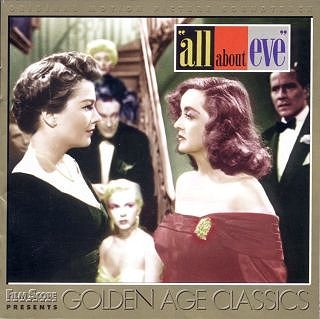
The most immediately striking thing about this album is how short the cues are, followed swiftly by how little music there is. Two complete scores are presented over 33 tracks, and in fractionally less than three-quarters of an hour.
Even including bonus stereo versions of the last two tracks, All About Eve (1950) just passes the half-hour mark, while Leave Her to Heaven (1945) features a mere 13 minutes and 25 seconds of score, for a film with a running time of 111 minutes. What is so surprising is that we often take it for granted that films from the 'Golden Age of Hollywood' featured more or less wall-to-wall music, that the subtle placing of limited amounts of score was something which developed later, in the 60's and 70's. Well no one told Alfred Newman what to do, he was the head of the music department at 20th Century Fox when these two films were made, and he surely scored these movies the way he saw fit. At 138 minutes, All about Eve features more than an hour-and-three-quarters of screen time without music.
Leave Her to Heaven was made just as film noir was gathering pace, and pitches itself somewhere between that genre and the often disparaged 'women's picture'. Gene Tierney plays Ellen, according to Fox's own production notes, a 'psychopathic demon', and clear forerunner of Glenn Close's vengeful jealous lover in Fatal Attraction (1987). This is similar dark psychological territory to that explored by Miklos Rozsa in Double Indemnity (1944) and Lost Weekend (1945), and Bernard Herrmann in Jane Eyre (1944) (Newman hired Herrmann for the job.) There are seven cues, dominated by the slow, remorseless (heart)beat of a drum, brooding strings and acerbic, biting brass writing. Taut, cruel and far removed from any sentimentality, at least until the triumphant end, this is not the more familiar Alfred Newman of Wuthering Heights (1939) and The Hunchback of Notre Dame (1939). Today we are used to this style from the better known Rozsa scores mentioned above, so that without being especially distinctive, it does reveal another facet of Newman's craft, showing how he approached each film according to the particular needs of the drama. That said, the very limited and sometimes distorted 1945 sound is such that the tracks are more interesting for the serious film music buff, rather than simply enjoyable in their own right.
All About Eve a highly theatrical film in more ways than one, won six Oscars in 1950, and a nomination for Alfred Newman for best score. The dialogue dominated nature of the film (the drama revolves around three stage actresses, most notably Margo Channing, played by Bette Davis) meant there was little room for extended musical sequences. There are bold fanfares for the opening and closing sequences, while most of the cues last less than a minute, and accompany transitional scenes, portraying the characters of one or more of the leading actresses. On the album there are also short extracts from Liszt and Debussy, as well as stereo versions of the final two selections. Presumably Fox were experimenting with stereo prior to the launch of CinemaScope.
As with Leave Her to Heaven, this is psychological film scoring, with brief statements of themes, and a low-key romantic hue like a faint echo of Max Steiner's Gone With the Wind (1939) yet stripped of much of the glamour. Unlike Bernard Herrmann's The Ghost and Mrs. Muir, or The Trouble With Harry, where Herrmann's use of short, self-contained cells of material allows short tracks work well as independent music, many of the cues here are too fragmentary and locked to the fabric of the film to be of especial interest as pure music. This is not to say that this is not a good score, indeed, some would argue that it is a great one, but that as far as album listening goes, Newman is at his most enjoyable in those scores in which he can stretch into longer, more sustained compositions. Here the music is essentially even-tempoed character-delineating underscore, an interwoven set of variations on the three main themes, which, while it functions wonderfully as part of the film, is not something for which I can, try as I might, feel especial warmth.
Doubtless I shall be called a philistine, but for me this is simply too fragmentary and too repetitive to encourage making the required allowances for the (comparatively) poor sound quality. This is a release to delight hard-core film music buffs, for whom only the original will do, but perhaps many younger fans such as myself might prefer a newly recorded suite with the music re-sequenced into longer cues. On a more positive note, the packaging is superb, with a beautifully reproduced colour publicity still on the front cover, colour poster reproductions for both films, a good selection on black and white stills and excellent notes by Doug Adams. Even the CD itself is elegantly designed, with stills from both films. Those with a taste for the 'Golden Age' and an infinite love of its classics will cherish this album, others may be less enthused, but all should applaud the fact of the release itself, and the enthusiasm for film music which makes such albums possible.
Reviewer
Gary S. Dalkin

Joel McNeely conducts the Royal Scottish National Orchestra
VARÈSE SARABANDE VSD-5806 [53:01]

Varese-Sarabande is the Rolls Royce of film score record companies. Their documentation and design is excellent. Technical qualities are high and performances sympathetic. The RSNO are seasoned adepts when it comes to re-recording and the City Halls, Glasgow now often resound to musico-cinematic glories of times gone by. The City fathers must be pleased, as must the RSNO bankers.
The orchestra goes from strength to strength although its concert glory days coincided with the tenure of Neeme Järvi. His departure hit the orchestra hard. I recall Michael Tumeltys Glasgow Herald reviews of concerts during the J4rvi days. The orchestras management should have pleaded with J4rvi to stay in much the same way as the BBCSO should have when Rozhdestvensky packed his bags during the 1980s. I digress - nothing new there.
V-Ss usual strengths are on display but the whole, while alive to the subtle shift and glow of the texture, does not captivate me. For comparison I went back to the very generous Australian LABEL X coupling of 37.30 of music from Kane and 39.10 from The Magnificent Ambersons. The LABEL X account has a greater sense of fluency and musical give and take. Listen to track 4’s ‘Snow Picture’ which ought to be the very peak of ecstatic release. In practice it seems rather stilted like an actor reading his lines rather than emoting. This is by no means the only example.
The Aussie disc has terrific emotional concentration and must be my first recommendation. The V-S is never less than good and technically it is notches above the Aussie. In the Aria it has a better voice in Janice Watson than Rosamund Illing on Label X. Watson seems secure and never outfaced by the Sibelian accents of this most grandiloquent aria. Whenever I hear this I wish Herrmann had actually written the rest of the opera.
As the most exhaustive document of the Kane score you will find no competition. This must surely be the fullest record of the score: 37 individual tracks plus three bonus tracks. Set against this the 15 tracks (and sixteen minutes less music) on Label X. I suppose that it is rather unfair to compare the two since they are not an exact match and Label X includes a very major slice of the Ambersons music. However from a purely musical point of view Label X carries the day delivering a more satisfyingly rounded experience than the Varese-Sarabande. I did not feel unduly deprived by the lack of the just over quarter of an hour of music on Label X. Of course the Label X also comes with most of the Ambersons music - two scores for the price of one.
Quick summary: Varese-Sarabande - good, brilliant technically, first class document of the score; Label X - great performances, so-so technically but never less than good ... and comes with the Amberson music. BMG-RCA Gerhardt suite - the best musically, even less music than Label X, but sheer magic. Overall recommendation: get the Label X if you can find it.
Reviewer
Rob Barnett

Rosamund Illing (soprano); Neville Taweel (violin); Australian Philharmonic Orchestra conducted by Tony Bremner
Label X ATM CD 2008 [78:16]
[I cannot offer any help in finding this disc. Even the Australian Association of Independent Record Labels does not lists them. - Len]
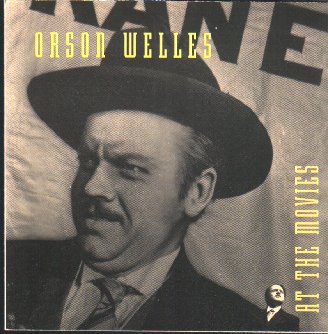
This Australian CD is well worth seeking out. The two scores are classics of Herrmann's earliest film days in the 1940s. Both are eclectic and extremely tuneful works recalling music which he either knew from score or which would have been in his active CBS Symphony Orchestra repertoire. He was a conductor of questing and receptive character. This shows here both in the vivid influences and in the many tributaries which flowed into and out of the furnace of his blow-torch imagination.
While Kane is sumptuous, dark, grand, nostalgic and powerful, Ambersons has a touch of angst but much that is urbanely rather than wildly emotional. Kane is Gothick - rich in incident. The extremely fine performance brings these qualities out. It is very good to hear this music at fuller length than the brief suite by which most people know the music from the RCA Gerhardt Classic Film Music series. The Dies Irae theme is heard or sketched in several times. Ms Illing is in good voice though not quite a match for the young Kiri Te Kanawa in the now elderly but still rich Gerhardt analogue recording.
Track 1 is gloomy but sweet. A cool flute parts the storm clouds.This is acidically Gothick achieving immediacy and impact without the twelve-tone palette. Sibelius is clearly an influence. If the Torn Curtain score is too inhumanly chilly Kane represents a couple of degrees greater warmth.
Track 3 has marked Finzian resonances. Track 4 mixes, in raucously cocky march mood, the voices of Kurt Weill and Shostakovich. Dies Irae puts in another appearance and then we get a march out of the Prokofiev pocket-book. Track 5 returns to the cheeky little march we heard in Track 4. This dissolve into a charming miniature waltz sequence.
The next track has a prominent solo violin in what develops into an icy slate-grey serenade. Track 7 is the famous music depicting the sweet and then decaying relationship between Kane and his new wife. This is redolent of Palms and Grand Hotel. The fluttering flute is every bit as good as Gerhardt's on RCA/BMG.
Tension is deftly built and sculpted in the repeating harp motif inTrack 8. There is a hint of A Late Lark (Delius) and the Finzi clarinet concerto although the Herrmann pre-dates the Finzi work by almost a decade. This is a most impressive track.
After a mysterious Baxian opening an explosive march strides in exuding confidence. It starts in Prokofiev style sounding for all the world like a refugee from Prokofiev's Classical Symphony and stops along the way to give us a reminiscence of Mahler.
Salammbo's Aria is presented by orchestra and conductor for all it is worth (arguably more). Rosamund Illing is extremely good but without the creamy triumph of Kiri te Kanawa's young voice. The aria may well be known to you but the layer cake (gateau I should say) of Reyer, Delibes and Massenet is wonderfully confected. Orchestrally this does not have quite the whip-crack definition of Gerhardt. This is followed by a multi-tracked segment which is a montage of Illing's voice presented in a multi-image kaleidoscopic mirror ending in a down-the-sinkhole vocal effect at the end.
Track 11 (Xanadou) is heavily tense and clouds drift across the moon. Track 12 gives us more Prokofiev. The next sequence returns to a sour curdled Weillian style; decadence melting into Grand Guignol. I caught myself thinking of the atmosphere of the horror stories of de Maupassant and especially The Horla.
Glass Ball has a hollow tread deep in the foundations. Old age has caught up with Kane. In the finale there is a sense of late fulfilment in the horns which play quietly surging briefly to a climax. However skulls stare out of the casements.
The Magnificent Ambersons is a very different film. It portrays domestic tensions and oppression in a late nineteenth century style. The music is refined and occasionally Palm Court material although psychological tensions are always well voiced. The music has a Gallic accent. Landaus click and canter through cobbled streets and metalled lanes. It is all quite urban and urbane. Poulenc comes to mind and Prokofiev also and this hits you with force at the start of track 16 with a sparkling trumpet solo.
There is a wonderfully vitreous sleigh ride at track 17 - a highlight of the disc. Track 18 is quite modernistic - all percussion, bells, clanking and bell noises with some reminiscences of the previous track. First Nocturne sounds uncannily like Finzi - straight out of the British composer's Introit for solo violin and orchestra. Track 20 is a dark tale which becomes yet blacker in the next three tracks. Track 24 is the second letter scene and here the wind principals dance slowly around a stately sad theme which might have been for a Dead Infanta. The Second Nocturne treads the same twilight path as the First with a lead solo role for principal cello. Then follow two reveries cut from the same trunk as the Nocturnes although the second drifts lazily down into nightmare drowned depths. The Elegy is shabbily haunting, conjuring up drifts of skeletal leaves. End title returns to palms and civilised evening dress and touching base with Mahler's Adagietto.
This is an extremely recommendable disc which is well worth finding. It merits a prominent company licensing the tapes for easier distribution in Europe and USA.
Reviewer
Rob Barnett

Moscow Symphony Orchestra and Choir conducted by William T. Stromberg.
MARCO POLO 8.225078 [71:30]
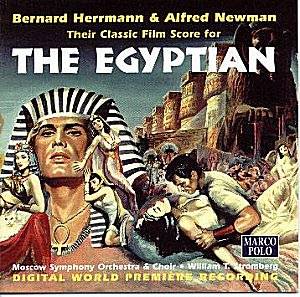
The Egyptian (1954) received a rough ride from the critics and it was not popular with audiences. (One reviewer remarked that it was "more risible than reasonable…")
Marlon Brando was originally slated to play the Doctor hero, Sinuhe, but he pulled out to be replaced by the wooden-faced (or rather glum and glowering-looking) and uncharismatic Edmund Purdom who seemed to be the kiss of death on so many films of this period. The film also starred Victor Mature, Peter Ustinov (the only actor to make any impression in this film) Bella Darvi (as the temptress Nefer, Nefer, Nefer) Gene Tierney, Michael Wilding, and Jean Simmons (as the martyred Merit). I add this detail because the usually excellent notes although analysing the cues in admirable detail, do not outline the plot in sufficient detail.
I will leave Rob Barnett to expound upon the detail of the score save to say that I was very impressed, and admired the way the music of Herrmann and Newman blend so well together. Their styles were quite different so this score is a tribute to their adaptability, sensitivity and supreme musicality. Herrmann’s contribution is more lyrical than usual and as in Citizen Kane he deploys his characterisation skills supremely well – note his damning portrayal of Sinuhe’s lust and Nefer Nefer Nefer’s greed and treachery. On the other hand, Newman tends to rein in his more refulgent tendencies and moves towards Herrmann’s more austere writing. His ‘Valley of the Kings’ and ‘Hymn To Aton’ are particularly successful and can be counted amongst his best creations. Both composers create a potent evocation of Ancient Egypt.
The sound is bright and clear and altogether I would place this new recording amongst the very best produced by the John Morgan/William T. Stromberg team.
Reviewer
Ian Lace

Rob Barnett adds:
We are becoming accustomed to this. Every new disc from this source is well prepared, the repertoire is chosen with acumen, the music is played and recorded with relish and the accompanying written material is as close to comprehensive as a 28 page booklet in one language (English) can get. Clearly Marco Polo had access to stills this time as they handsomely adorn this issues 28 page booklet (English only).
The Egyptian is one of those sword and sandal epics at which Hollywood excess excelled. Music plays a key part in the success of such things. Newmans and Herrmanns music is complementary and the seams are not obvious. Newman is a priest of the swooning string (and vocal) choir. Herrmann can do virtually anything and is easily the superior of the two composers. His imagination, translated into music and orchestral effect, is matchless although emotionalism is something that does not come easily to the Herrmann palette.
John Morgan does his usual masterful job and boils down a 100 min score to 71 min choosing the best. This is still a great deal of music.
Herrmann has us in the cupped palms of his hands from The Prelude (with its foreground-grabbing snarling trombones) onwards. Newman pulls off the same trick in ‘The New Pharaoh’ with horns echoing and re-echoing. Herrmanns salty dynamism and choler enliven ‘The Chariot Ride’ with its exciting antiphonal horn chase, the chaotic clamour of ‘Pursuit’ and the snorting brass of ‘Violence.’
In more atmospheric vein he gloriously portrays gloom (‘Ruins’), serenity (strings and plaintive woodwind in ‘The Red Sea’ and ‘The Nile’) and shifting exotic dreams (‘Nefer-Nefer-Nefer’). The harp and tambourine provide additional colour in ‘The Temple’. The Deed is celebrated in quiet serious strings following a tune of Prokofiev-like bearing. ‘The Harp and The Couch’ and the following track (‘The Perfection of Love’) wallow lightly and pleasantly in languor and contentment accompanying a strollingly high string theme.
Drama and local colour also come into ‘Taia’- an awkward dance and, speaking of dance, listen to Partys End for some sleekly sinuous pirouettes out of Balakirevs Symphonies or Ippolitov-Ivanov. Sibelius 1 and 2 are the wellsprings of The Rebuke - all brassy defiance. As for ‘The Homecoming’, this must have been a sour return with its howling Scythian clamour slashed through with Sibelian gusts. ‘The Tomb’ is sepulchral in the manner of Tchaikovsky 5 and Sibelius 1. Dance Macabre caterwauls in a glorious chaos indebted to the battle music from Prokofiev’s Nevsky score.
The Newman tracks are fascinating. ‘Her Name Was Merit’ is strikingly similar to a John Barry theme: Bond in sleepy romantic form. Akhnaton - those serene strings sphinx-like as in Red Sea and The Nile. ‘The Valley of the Kings’ is the longest track here - a tone poem in all but name. The repetitive tread of ‘The Hymn to Aton’ with chorus is hypnotic while Tchaikovsky must be the model for ‘Live For Our Son’. So too in its different gloomier way is the militaristic ‘Am I Dead?’ with its Mahlerian slouch (The Titan).
An indifferent film, maybe, but this score is a narcotic jag and a half. Hotly recommended.
Reviewer
Rob Barnett

OSTs
VARÈSE SARABANDE VSD-6052 [74:41]
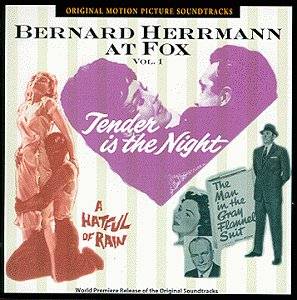
These 1950s and 1960s OSTs deliver the usual balance of authentic experience and sound degradation. Authenticity wins the day.
Tender is the Night (17 tracks) is the single largest helping on this silver platter. The first and last (1 and 17 - Hollywood-Rachmaninov wallow) tracks of the sequence are not by Herrmann. The score represents a fantasia for strings with only The Embrace touched with conventionality. Piercing poignancy and Sibelian elegies counterpoint ‘The Mirror’ which registers tellingly with its erupting terraces of string hysteria and the playful musette of ‘Vacation.’ The woodwind arabesques are reminiscent of the music for the fountain in Fleckers Hassan. ‘The Dawn’ is a deeply impressive evocation of the same line as Mussorgsky’s Dawn on the Moskva. A pretty dreamy manner is well sustained throughout. The sound quality very slightly distressed. The final (non-Herrmann) track is a woeful confection of cottonwool and caramel goo: avoid.
High throbbing strings deliver the tawdry theme of The Man in the Gray Flannel Suit. For the most part we are speaking of a score much afflicted with regret, chilly sheets of rain and November elegies with just a shudder of DSCH-style vibrancy and a final gloriously incongruous Hollywood sunrise. A Hatful of Rain (16 mins) is an extremely obscure score: all Hollywood bell-toll, jeering raggedy brass, motoric rhythmic pith and breathy string fanfares.
Excellent notes by Jon Burlingame (I hope to hear more from him) but no track timings and a Hatful of Rain is regrettably presented as a single track suite. The booklet includes stills from the films and monochrome reproductions of original theatre posters.
A nice piece of Herrmann memorabilia with the greatest rewards yielded by Tender is the Night. Not the place to start an exploration of Herrmann but with some good material. A valuable document.
Reviewer
Rob Barnett

************************************************************** EDITOR’S RECOMMENDATION January 2000
**************************************************************
SONY S2K51333 (2CDs). 51333
.
CD1 [66:11] Star Wars - Main Title
E.T. The Extra-Terrestrial - 'Flying Theme'
Superman - Main Title
Indiana Jones and the Temple of Doom - 'Parade of the Save Cildren'
Sugarland Express - 'Theme'
Jaws - 'Theme'
Olympic Fanfare and Theme - for Los Angeles Olympics 1984
Return of the Jedi - 'Luke and Leia'
The Reivers - 'Main Title'
The Empire Strikes Back - 'The Imperial March'
Indiana Jones and the Last Crusade - 'Scherzo for Motorcycle and Orchestra'
Empire of the Sun - 'Cadillac of the Skies'
Raiders of the Lost Ark - 'The Raiders March'
Close Encounters of the Third Kind - SuiteCD2 [73:46] Saving Private Ryan - 'Hymn to the Fallen'
Jurassic Park - 'Theme'
Schindler's List - 'Theme'
Hook - 'Flight to Neverland'
SevenYears in Tibet - 'Seven Years in Tibet'
JFK - 'Prologue'
Stepmom - 'The Days Between'
1941 - 'march'
Home Alone - 'Somewhere in my Memory'
Summon the Heroes - Olympic Games, Atlanta Georgia July 1996
Rosewood - 'Look Down, Lord'
Far and Away 'Theme'
Born on the Fourth of July - 'Theme'
Star Wars Episode 1; The Phantom Menace - 'Duel of the Fates'.
First of all I should mention that these are not from the original soundtrack recordings but are performances, in most cases, recorded some years after the release of the films. The earliest recordings are The Reivers (1969) Superman (1978) - the former one of John Williams's most appealing scores. All the music is conducted by John Williams with the London Symphony Orchestra, the Boston Pops Orchestra, the Boston Symphony Orchestra, The Skywalker Symphony Orchestra, and the Pittsburgh Symphony Orchestra plus an unnamed ensemble orchestra. The selections listed above speak for themselves and need no further comment from me. All sound fresh and exciting - only 'Cadillac of the Skies' the hauntingly beautiful theme from Empire of the Sun disappointed, I would like to have heard the theme blossoming in all its glory. Soloists include cellist Yo Yo Ma in the title theme from Seven Years in Tibet, trumpeter, Tim Morrison in the JFK and Born on the Fourth of July tracks, violinist Itzhak Perlman in Far and Away and Schindler's List, and guitarist Christopher Parkening playing 'The Days Between' from last year's underrated score for Stepmom. [It is a shame that a piano soloist and the lovely theme from Sabrina could not be included but you can't have everything]
Clearly not all the Williams scores are here but this is a first class representative collection recorded in stunning floor-board quivering sound - a true sonic feast.
Reviewer
Ian Lace

VARÈSE SARABANDE VSD-6077 [59:06]
The Magnificent Seven The Shootist
The Comancheros
True Grit
Wild Wild West
To Kill A Mockingbird
My Left Foot
Frankie Starlight
The Age of Innocence Lost in Yonkers
A Rage in Harlem
The Grifters
The Black Cauldron
The Great Escape
Buddy
The Ten Commandments
Following on from their JohnWilliams collection, Varèse Sarabande now present this second compilation in their ‘Great Composers’ series. All the sixteen tracks are taken from previously issued Varèse albums, some of which have been reviewed on this site over the last eighteen months. The rousing opening track The Magnificent Seven played by the RSNO conducted by Joel McNeely sounds magnificent as does the popular The Great Escape theme from the same artists. This attractive package comprises a fair representation of the music of this great master of the genre including fine sweeping western themes (mostly for films starring John Wayne) like the superb theme for The Comancheros and the oddity of the western genre, this year’s Wild Wild West. The highlight for me is Bernstein’s inspired music for To Kill a Mocking Bird that captures the essence of childhood. Two more valuable scores inspired by Bernstein’s own childhood are included Lost in Yonkers and A Rage in Harlem. The diamond hard and gritty The Grifters score contrasts with the tenderness of My Left Foot and the whole is rounded off with the majesty of The Ten Commandments.
Recommended
Ian Lace

Original scores and transcriptions played by Massimo Palumbo (piano)
CHANDOS CHAN 9771 [59:12]
Save around 22% with
Crotchet
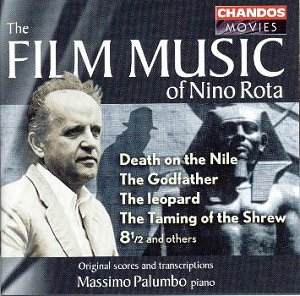
The Godfather
The Glass Mountain
Fanciulle di lusso (Luxury Girls)
Death on the Nile
Romeo and Juliet
Fantasmi a Roma (Ghosts in Rome)Obsession
8½
Il gattopardo (The Leopard)
Giulietta degli spiriti (Juliet of the Spirits)
The Taming of the Shrew
Quel bandito sono io (Her Favourite Husband)These are Nino Rotas’s own piano trancriptions of his film scores that he used to like to play for his own, and his friends’ amusement, and sometimes in recitals. A friend of the composer (Rota died in 1979), Piermarco De Santi, who has contributed the booklet notes, remembers that Rota loved, especially, his music for the British film, The Glass Mountain, which was very popular here in the UK in the late 1940s. Rota invariably ended his recitals with the theme from this romantic film. Massimo Palumbo includes its grand sweeping cadences in this collection together with the film’s slow waltz.
This programme includes both music that is familiar and scores that are much less well-known. Palumbo eschews the over-dramatic approach, more apparent in the full-blown orchestral versions of many of these scores originally heard in the theatre. His quieter, more restrained renderings of The Godfather’s ‘Love Theme’, Waltz and ‘Michael’s Theme’; and the well-loved themes from Death on the Nile and Romeo and Juliet allow all their intrinsic beauty to be fully revealed.
Now about the lesser-known scores. Ghosts in Rome, of which I know nothing, is light-hearted material suggesting these ghosts are harmless and benign, more interested in having fun than scaring people. The music begins meditatively, nostalgically then the ghosts begin to dance: first to the rhythms of the 1920s and 30s with some ghosts a bit leaden-footed, then more graceful feet take over in a minuet which eventually gives way to a wilder boogie-woogie. We leave as ‘The ghost knight [has some fun with] the nurses’ – or is it the nurses having fun with the proud knight? Luxury Girls appears to be another comedy. Starchy, prim and proper music for the college and the teachers contrasts with the mischievous pranks of the girls. ‘Towards College’ includes music in the style of the minuet and barcarole and the ‘Dance Lesson’ is very much ballet music – all cheekily lampooned. Obsession (1948), another British film starring Robert Newton was about a doctor who decides to kill his wife’s lover by imprisoning him in a lonely cellar while he accumulates enough acid to destroy all trace of his body. Palumbo plays the melodramatic music in the late Romantic/gothic tradition, full of intensity and bravura; the score also includes some passionately romantic material and music that suggests French folk tunes. The ‘Neapolitan samba’ from Her Favourite Husband which closes the recital is full of colour and vibrant rhythms.
Palumbo realises the proud grandeur of the Main Titles music from The Leopard and gradually builds up to a deeply-felt rendering of the magnificent sweeping, romantic main theme. 8½, in contrast, is all delicate fragility while Juliet of the Spirits is all atmosphere and evocation in ‘Dew on the Frogs, and simple innocence in ‘Nun’s theatre.’
The short suite from The Taming of the Shrew comprises the genial ‘Sweet Italy’ that includes medieval dance music reminiscent of Respighi in his Ancient Airs and Dances mode, while ‘Love in Padua’ slyly suggests early marital strife and the shrewish behaviour of Kate.
A delightful recital and ideal for late night relaxed listening
Reviewer
Ian Lace

Slovak Radio Symphony Orchestra
Marco Polo 8.223466 [58:48]
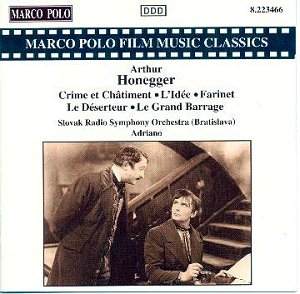
(Note: This recording has been available for some time - it was made in 1992)
Honegger scored some forty films over about thirty years. His legacy had a profound effect on the history and development of film music. In fact the early section of the cue 'Raskolnikov - Sonia' from Crime et Châtiment reminds one very much of some of Bernard Herrmann's music from Vertigo where James Stewart's character is following Madeleine (Kim Novak) through the streets of San Francisco.
Farinet ou L'Or dans la Montagne (1938) was set in the Swiss mountains and was about a young man accused of forgery who is betrayed by a jealous girl he has spurned. The music has a rugged sweeping out-of-doors feel, and the main tune sounds curiously like a hornpipe. There are nice smooth rustling string figures suggesting breezes through the trees. This pastoral calm is contrasted with hectic, vigorously dramatic elements for the chase music as his pursuers close in for the kill. Honegger uses an alto saxophone very evocatively.
Crime et Châtiment, after the novel by Dostoyevsky, was about Raskolnikov, a student, obsessed by a murder he has committed, and his involvement with a prostitute whom he wishes to save. The more he feels attracted to Sonia, the more he feels the need to confess his crime to the police, who already suspect his guilt. Honegger uses the Ondes Martinot impressively as a solo instrument for leitmotifs, as a reinforcement of the bass-line or as an atmospheric addition to the score. This score is most impressive, particularly the music for 'Départ pour le crime', where there is a growing and pervasive sense of doom occasioned by deep tolling bells and persistent, incessant dark ostinatos and canon-like counter motifs. Weird creepy effects abound from the woodwinds and Ondes.
Le Déserteur ou Je t'attaendrai (Fragment symphonique, 1939) was about a World War I soldier who deserts his troop to visit his parents and his fiancée. It is a score of considerable charm and power. Tender, poignant moments are contrasted with stealthy figures as the deserter tries to stay hidden from his pursuers; and then more desperate impassioned music as the hunt for him draws nearer.
Le Grand Barage appears to have been about a huge mountain reservoir. The brief three-minute suite is majestically imposing with some sparkling watery effects.
L'Idée is the most substantial score on this album lasting some 25 minutes. The film was one of only two animated features that Honegger scored. The visual images were based on woodcuts by the Belgian expressionist painter and sculpter, Frans Masereel who was a life-long militant pacifist, opposed to all forms of oppression. War, man's loneliness in the modern world and social criticism are all constant themes in his works. Quoting the booklet notes, " More than any other film score by the composer, this contains typical devices of the film and theatre music of the 1920s and 30s, making it sound, at times, like Hindemith or Kurt Weill. The idea itself, its lyrical leitmotif stated and developed at the beginning by a solo of 39 bars for the Ondes Martinot, is represented by the silhouette of an immortal, naked girl, inspiring mankind and leading revolt against all kinds of oppression."
Honegger's music for L'Idée is large and heroic in scope taking in many diverse forms and moods. There are happy and blues jazz elements; despondent and affirmative marches, and music evocative of relentless soul-destroying machinery. The music builds up into an impassioned climax using material reminiscent of Holst's 'Mars' from his The Planets Suite, before a peaceful and serene conclusion.
Adriano delivers very persuasive performance of all these fine scores
Reviewer
Ian Lace

Slovak Radio Symphony Orchestra
Marco Polo 8.223287 [77:13]
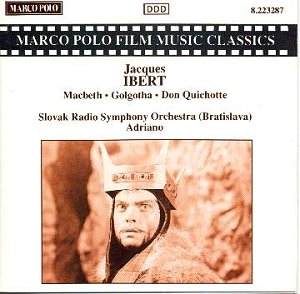
(Note: This recording has been available for some time; it was made in 1990)
Jacques Ibert, like Arthur Honegger, Georges Auric and Darius Milhaud, was a member of that group of contemporaneous composers known as Les Six. All contributed potent scores for French (and, sometimes, other) films. Jacques Ibert (1890-1962) wrote six operas (two serious and four comic), seven ballets, a dramatic cantata, incidental music for six stage works and four radio scores. His name appears in the credits of some thirty feature films and a few documentaries. It is clear from this recording that he had a gift for dramatic expression in his music.
Macbeth. This was the 1948 production by Orson Welles. Ibert's score is savage, pungent and darkly dramatic. His orchestration requires piano, celesta, vibraphone, harp and a large percussion battery including Millboard-bells, tabor and Chinese gongs. All the wind instruments are doubled but the string section is slightly smaller than normal. The result is often weird and disturbing. The Overture opens in quiet eerie chaos, the music sort of drips along and there are peculiar syncopations in its march. One of the score's many interesting aspects is the inclusion of a "breathing choir in the witches' scenes, set against eerie parts for piano, harp, celesta and percussion with string harmonics… A drinking sequence in the throne-room preceding Banquo's murder, is conceived in a grotesque bass-tuba solo, echoed by gurgling bassoons, and double-bassoon and by rhythmic figures for the strings. Many regarded Ibert as backward-looking in style and sticking in a bit if a rut; but this score, with so many innovations, looks more towards the avant-garde of the day. There are some comic effects to lighten the darkness and there is a real Scottish swirl about the triumphant marches for Macduff's armies.
Don Quichotte (1933). Chanson de Sancho (orchestrated by Adriano) and Quatre Chansons de Don Quichotte. The score was written for G.W. Pabst's classic film. Pabst created Don Quichotte for Feodor Chaliapin (or Shalyapin as spelt in the booklet, either is correct). The original music was recorded on 78's in 1933 by Chaliapin with the composer conducting providing a moving historical document. Quoting from Adriano's booklet notes: "The Quatre Chansons call for an ensemble of only five instruments in the first song and full orchestra in the rest, except for occasional variation in the use of wind and percussion instruments. The overall orchestration provides solo parts for saxophone, bass-clarinet, tuba, guitar and/or cembalo, timpani, harp and vibraphone with single wind and a string section reduced in numbers. The vocal line, set in a discrete and sophisticated Spanish mood, makes this cycle a masterpiece in the repertoire of French song." American-born Henry Kiichli has a fine-grained lightish bass voice and he adds distinction and sensitivity to these fine songs.
Golgotha (Suite 1935). This suite from the film of Our Lord's Passion was assembled by the composer, himself. Again the Ondes Martinot plays a prominent role. The opening cue, 'La fête de Pâques' is a joyful celebration as Christ enters Jerusalem in triumph. Ibert creates a rather odd musical effect, which I infer might depict Christ's entry into the City on an ass, but it sounds rather like a locomotive chugging along! Later in the cue, harsher martial sounds, clearly representing the occupying Roman soldiers, dampens the celebrations. 'Les vendeurs au Temple' are scattered by strict music and you hear the scattering of gold and silver pieces as Christ angrily admonishes the traders for desecrating the Temple. 'Le Calvaire' is a mournful procession along the Via Dolorosa and 'La crucifixion' is a magnificent musical compression of many conflicting moods: an indictment of man's blindness and bestiality and Christ's compassion. The music is very reverent and the style is in places reminiscent of Berlioz. The final 'L'agonie and La mise au tombeau' has storm music, as Christ dies in the cross, with screaming Ondes Martinot vividly evoking lightning bolts and the suite ends with the lovely funeral procession à la Satie.
Adriano not only delivers another compelling collection but he is to be congratulated on his restoration work and for sensitively augmenting Ibert's original thin orchestrations (for the primitive soundtracks of the day) to an orchestral fabric suitable for modern recording purposes.
Reviewer
Ian Lace

OST Songs performed by Al Jolson and Alice Faye
VARÈSE SARABANDE VSD-6089 [54:03]

Rose of Washington Square (1939) starred Alice Faye, Tyrone Power, Al Jolson, and Louis Prima and his Band. This was the film that provoked Fanny Brice to sue 20th Century Fox for $75,000 for invasion of privacy (the defendants settled out of court). On the surface the story is about the tribulations of a Broadway singer in love with a worthless husband. As Halliwell states, it appeared to be a "revamping of the Fanny Brice story; smartly done, but the material interpolated for Al Jolson is what makes the film notable."
Rose of Washington Square was the third and final teaming of Tyrone Power and Alice Faye. In 1938 they had starred together in Fox’s In Old Chicago, which had the Great Fire as its spectacular climax; then they were teamed again in another spectacular and memorable musical, Alexander’s Ragtime Band that carried over 20 Irving Berlin numbers.
The music on this CD, beautifully refurbished, is absolutely marvellous. Wonderful song follows wonderful song – a veritable treasure chest of marvellous melodies from the era between the World Wars – and earlier. They include:-
‘Pretty Baby’ performed by Al Jolson.
‘I’m Sorry I Made You Cry’ sung by Alice Fay
‘I’ll See You in My Dreams’ – Alice Faye
‘The Vamp’ – Alice Faye and Chorus
‘I’m Always Chasing Rainbows’ – Alice Faye (an out-take this one)
‘Rock-a-bye Your Baby With a Dixie Melody’ – Al Jolson
‘Toot Toot Tootsie’ – Al Jolson
‘I’m Just Wild About Harry’ – Alice Faye
‘California, Here I Come’ – Al Jolson
‘I Never Knew Heaven Could Speak’ – Alice Faye
‘My Mammy’ – Al Jolson
‘April Showers’ and ‘Avalon’ – Al Jolson
‘My Man’ – Alice Faye
‘Rose of Washington Square’ – Alice Faye and Chorus in an extended 8-minute track with a significant orchestral element.As if all that was not enough, there are eight bonus tracks: alternative versions of six of the songs (two versions of ‘My Man’). The interesting thing is that you hear the voices of the recording technicians and the producer at the beginning and ending of these tracks.
A fabulous nostalgic trip
Reviewer
Ian Lace

OSTs
VARÈSE SARABANDE VSD-6090 [72:28]
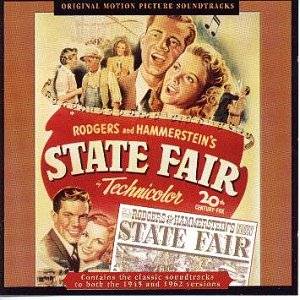
State Fair was the only musical Richard Rodgers and Oscar Hammerstein wrote specifically for the screen. It was filmed twice – in 1945 and again in 1962. The original 1945 version starred the lovely Jeanne Crain (whose songs were sung by Louanne Hogan), Dana Andrews, Vivian Blaine, crooner Dick Haymes Charles Winniger, and Fay Bainton. I will confess to having seen it on its first theatrical release (at the tender age of nine) and remembering very well its lovely tunes. And how well they have stood the test of time: ‘It Might As Well Be Spring’, ‘That’s For Me’; ‘It’s A Grand Night For Singing’ and ‘Isn’t It Kinda Fun.’ All these songs and others from the original soundtrack are here together with a clutch of others; all delivered with sparkle and charm.
The 1962 remake of State Fair lost the simple charm of the original. It was set in a much more modern and larger fair with a false gloss and sophistication (and more modern musical backings). All this jarred with the simplicity of the story of a family coming to the local rural State Fair; mother to win a pie-making competition, father to win the prize pig contest, while their teenage children find romance. The stars this time were Pamela Tiffin (also requiring a voice – Anita Gordon), Pat Boone, Bobby Darrin, Ann Margaret and Tom Ewell. Still, restricting my observations to the music on this CD, the 1962 artists equip themselves very well and it is a pleasure to be reminded of the laid back style of Pat Boone as he sings ‘That’s For Me’ (even if one might deplore the blousy instrumentals that ruin it). Bobby Darin’s singing of ‘This Isn’t Heaven’ a new song with a lyric by Richard Rodgers charms too. ‘More than Just A Friend’ with a lugubrious vocal by Tom Ewell (serenading his prize pig) is distinguished by a glittering orchestral backing that evokes all the sounds of the Fair’s merry-go-rounds and stalls. Another interesting addition is Alice Faye singing the slyly amusing ‘Never Say No To A Man (simply avoid saying ‘yes’ to him).’
A lovely nostalgic trip.
Reviewer
Ian Lace
1945 version:

1962 version:

OSTs
RCA Italy OST 102 [34.09]
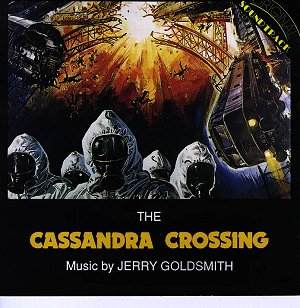
The first hint that The Cassandra Crossing, despite its big-budget and international cast, is a cheesy actioner is evident when O.J. Simpson’s and Martin Sheen’s names appear early in the credits, immediately following Sophia Loren and Richard Harris. What follows is one of those Euro-American conglomerate efforts that work best as tax-shelters for the stars and producers. They also make good filler for late-night TV. So why does Jerry Goldsmith bother with such turkeys? This isn’t early Goldsmith, mind you -- by 1976, when Sir Lew Grade was assembling this mishmash, Goldsmith had become (deservedly) Hollywood’s most sought-after composer, with classics such as Patton and Chinatown on his resume. That same year, he would win the Academy Award for The Omen. Nevertheless, there he is, struggling to envelop the cinematic silliness of Cassandra Crossing with music that makes it seem somehow worth watching. The wonder of it is, he succeeds. The Cassandra Crossing -- in which a train heads toward a doomed bridge while carrying a cast of disparate characters, one of whom carries a deadly plague virus -- contains vintage Goldsmith action music accompanied by inventive orchestration.
The cue "Break-in" is at times reminiscent of his earlier Planet of the Apes and The Sand Pebbles. Later, in "The Climber," Goldsmith creates a maelstrom of music, pulling out all the stops as he mixes low brass and percussion with woodwinds in a middle register.
One of the film’s more outlandish action scenes involves an attempted rescue of train passengers via helicopter, which swoops in fast and low to hover over the train. But wait! The train’s about to pass into a tunnel and the helicopter will crash into the side of the mountain ...whew! It pulled up and away just in time! Sounds corny, but believe me,
it works, thanks largely to Goldsmith. Contrasting with the excellent action cues is a simple, four-note love theme that also functions as the main theme. It’s most lush appearance on this recording comes as an orchestral version of a song ("It’s All a Game.") Also elbowing its way onto this recording is a song Goldsmith had nothing to do with, and which also seems to have nothing to do with the movie. Subtract this pair of cues, however, and what’s left is a good half-hour of top-notch Goldsmith action music, making this film score a must for die-hard fans of the composer. Others can safely pass on this one. In any event, finding The Cassandra Crossing may not be easy. The liner notes of the recording reviewed here mention previous U.S. and Japanese releases, and I know that Citadel issued an LP back when the film was released. But even this RCA release, a re-mastering that lists at more than $20, can be a challenge to find. So where did I get mine? At a Barnes & Noble book and music chain store -- which just proves you never know where you’ll find a rare film score!
Reviewer
John Huether

Return to January index
 |
Search the Crotchet database from here |
| Discs
on these pages are offered for sale. There is also a page of search
engines from a selection of on-line retailers
here.
Please support this web-site by buying your discs here. Disclaimer: Every effort is made to make sales links to the correct disc but, in the end, you must take responsibility for checking that what you are purchasing is what you want. Some of these discs were not actually available for sale at the time of posting but a link has been made in anticipation of their forthcoming availablility. |
Return To Film Music on the Web
e-mail: info@musicweb.uk.net